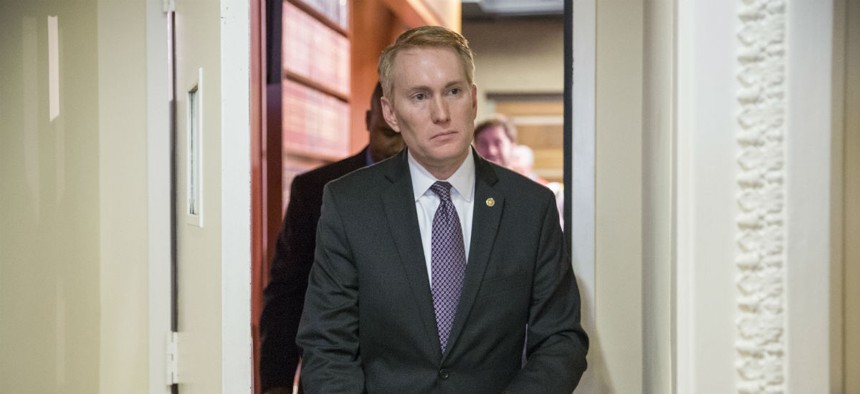
Sen. James Lankford, R-Okla., says agencies need to do a better job of rooting out waste. J. Scott Applewhite/Associated Press
Pentagon, Treasury Top List of Agencies Struggling with GAO Recommendations
Senators cite Government Accountability Office and watchdogs as best source of ideas for ways to save money.
A Senate subcommittee last week put the spotlight on two major sources for ideas to save agencies money: Congress’s nonpartisan Government Accountability Office and the 72 inspectors general scattered around the government, some serving more than one agency.
“With a massive $19 trillion federal debt and a half-a-trillion-dollar deficit, the federal government must identify and eliminate inefficiencies, duplication and wasteful spending wherever they exist,” said Sen. James Lankford, R-Okla., convening a Dec. 10 hearing of the Homeland Security and Governmental Affairs Subcommittee on Regulatory Affairs and Federal Management. “GAO saved taxpayers $74 billion last year and has saved half-a-trillion dollars since 2003,” he noted. But about “20 percent of the GAO recommendations, and billions more in savings, are still unaddressed. We cannot ignore obvious solutions to our deficit.”
Ranking member Heidi Heitkamp, D-N.D., noted that GAO tracks progress on its recommendations in a manner more consistent than inspectors. “It is a little more challenging to know how federal agencies are responding to inspectors general recommendations,” she said. “While IGs are required by law to provide semi-annual reports to Congress tracking audit recommendation implementation, each IG has their own system for tracking the recommendation implementation.”
According to GAO, there remain 4,800 outstanding recommendations at major agencies. Topping the list, in rank order as charted by Lankford’s panel, are the Defense Department with 1,004 outstanding recommendations, followed by Treasury (409), Health and Human Services (398), Homeland Security (394), and Transportation (367).
Comptroller General Gene Dodaro testified that since 2003, GAO’s work has helped deliver more than half a trillion dollars in financial benefits and about 17,000 program efficiency reforms. About 84 percent of GAO recommendations were implemented from 1983-2008, according to a February report published by Deloitte University Press.
On the infamous high-risk list GAO has compiled since 1990 to target waste, fraud and mismanagement, only one-third of the items have been addressed in a quarter century.
“Since fiscal year 2010, GAO’s work has resulted in over $330 billion in financial benefits and over 8,000 program and operational benefits,” Dodaro said. In fiscal year 2015 alone, GAO’s work yielded $74.7 billion in financial accomplishments—a return of about $134 for every dollar invested in GAO.”
The two examples of missed opportunities he cited were the Pentagon’s handling of the over-budget F-35 joint strike fighter, and the Medicare program’s efforts to improve accuracy in judging disability claims.
“GAO continuously engages with executive branch agencies to ensure recommendations are implemented,” Dodoro said. For example, it “regularly follows up with agencies on its recommendations and posts their status online. This year GAO sent letters to the heads of key executive branch agencies identifying unimplemented recommendations that warrant priority attention.”
Representing the inspectors general was Michael Horowitz, the Justice Department’s top watchdog who also chairs the inspectors general council. “Together, the recommendations and investigative recoveries of the IG community result in significant improvements to the economy and efficiency of programs across the government, with potential savings totaling approximately $46.5 billion in fiscal year 2014.” His agency has closed about 84 percent of IG recommendations, he estimated under questioning, leaving about 700 outstanding.
“With the IG Community’s aggregate fiscal 2014 budget of approximately $2.6 billion, these potential savings represent about an $18 return on every dollar invested in the OIGs,” Horowitz said, citing, as did Dodaro, staffing shortfalls. “That means that for every dollar spent on the oversight conducted by inspectors general, there is a potential savings of $18 for American taxpayers. These potential savings include nearly $4.3 billion in questioned costs and over $9.5 billion in funds that could be put to better use by government agencies.”







